Thermal Conditions in the City of Poznań (Poland) during Selected Heat Waves
Abstract
:1. Introduction
- define multiannual changes in the occurrence of hot days and heat waves in Poznań in the years 1966–2015;
- characterise thermal conditions in the city during selected heat waves in the years 2008–2015.
2. Research Area, Data and Methods
- conversion of the values measured by the satellite sensor (in the thermal channel) for each pixel to the energy radiation value;
- conversion of radiation values to radiation temperature using Planck’s law;
- calculation of the land surface temperature under the Stefan–Boltzmann law, taking into account the differentiation of the emissivity of different surfaces;
- conversion of the land surface temperature (LST) to the air temperature at 2 m above the surface layer (Tasl) using a linear regression model. This model is used to estimate the air temperature (Tasl) value when the LST value is known:a, b—linear regression coefficient.Tasl = a × LST + b.
3. Results
3.1. Tmax in the Summer Season in the Years 1966–2015 (Poznań–Ławica)
3.2. Hot Days and Heat Waves in the Years 1966–2015 (Poznań–Ławica)
3.3. Tmax, Hot Days and Heat Waves in the City Area in 2008–2015
3.4. Heat Waves of 2010 and 2015
3.4.1. Tmax in the Heat Waves
3.4.2. Daily Air Temperature on 12 July 2010 and 15 August 2015
3.4.3. Air Temperature and Land Use
3.4.4. Atmospheric Circulation on 12 July 2010 and 11 August 2015
4. Discussion
5. Conclusions
Acknowledgements
Author Contributions
Conflicts of Interest
References
- IPCC. Climate Change 2013: The Physical Science Basis. Contribution of Working Group I to the Fifth Assessment Report of the Intergovernmental Panel in Climate Change; Cambridge University Press: Cambridge, UK, 2013. [Google Scholar]
- Lhotka, O.; Kyselý, J. Characterizing joint effects of spatial extent, temperature magnitude and duration of heat waves and cold spells over Central Europe. Int. J. Climatol. 2015, 35, 1232–1244. [Google Scholar] [CrossRef]
- Keggenhoff, I.; Elizbarashvili, M.; King, L. Heat Wave Events over Georgia since 1961: Climatology, Changes and Severity. Climate 2015, 3, 308–328. [Google Scholar] [CrossRef]
- Unkašević, M.; Tošić, I. Seasonal analysis of cold and heat waves in Serbia during the period 1949–2012. Theor. Appl. Climatol. 2015, 120, 29–40. [Google Scholar] [CrossRef]
- Tomczyk, A.M. Hot weather in Potsdam in the years 1896–2015. Meteorol. Atmos. Phys. 2017. [Google Scholar] [CrossRef]
- Tomczyk, A.M.; Sulikowska, A. Heat waves in lowland Germany and their circulation-related conditions. Meteorol. Atmos. Phys. 2017. [Google Scholar] [CrossRef]
- Koffi, B.; Koffi, E. Heat waves across Europe by the end of the 21st century: Multiregional climate simulations. Clim. Res. 2008, 36, 153–168. [Google Scholar] [CrossRef]
- Kyselý, J. Recent severe heat waves in central Europe: How to view them in a long-term prospect? Int. J. Climatol. 2010, 30, 89–109. [Google Scholar] [CrossRef]
- Piniewski, M.; Mezghani, A.; Szcześniak, M.; Kundzewicz, Z. Regional projections of temperature and precipitation changes: Robustness and uncertainty aspects. Meteorol. Z. 2017, 26, 223–234. [Google Scholar] [CrossRef]
- Luber, G.; McGeehin, M. Climate change and extreme heat events. Am. J. Prev. Med. 2008, 35, 429–435. [Google Scholar] [CrossRef] [PubMed]
- Błażejczyk, K.; Kuchcik, M.; Milewski, P.; Dudek, W.; Kręcisz, B.; Błażejczyk, A.; Szmyd, J.; Degórska, B.; Pałczyński, C. Urban Heat Island in Warsaw—Climatic and Urban Conditionings; Wyd. Akademickie SEDNO: Warszawa, Poland, 2014; ISBN 978-83-7963-018-9. [Google Scholar]
- Gabriel, K.M.A.; Endlicher, W.R. Urban and rural mortality rates during heat waves in Berlin and Brandenburg, Germany. Environ. Pollut. 2011, 159, 2044–2050. [Google Scholar] [CrossRef] [PubMed]
- Kuchcik, M. Mortality in Warsaw: Is there any connection with Feather and air pollution? Geogr. Pol. 2011, 74, 29–45. [Google Scholar]
- D'lppoliti, D.; Michelozzi, P.; Marino, C.; De’Donato, F.; Menne, B.; Katsouyanni, K.; Kirchmayer, U.; Analitis, A.; Medina-Ramón, M.; Paldy, A.; et al. The impact of heat waves on mortality in 9 European cities: Results from the EuroHEAT project. Environ. Health 2010, 9. [Google Scholar] [CrossRef]
- Vandentorren, S.; Suzan, R.; Medina, S.; Pascal, M.; Maulpoix, A.; Cohen, J.C.; Ledrans, M. Mortality in 13 French cities during the August 2003 heat wave. Am. J. Public Health 2004, 94, 1518–1520. [Google Scholar] [CrossRef] [PubMed]
- Kawashima, S.; Ishida, T.; Minomura, M.; Miwa, T. Relations between surface temperature and air temperature on a local scale during winter nights. J. Appl. Meteorol. Climatol. 2000, 39, 1570–1579. [Google Scholar] [CrossRef]
- Voogt, J.A.; Oke, T.R. Thermal remote sensing of urban climates. Remote Sens. Environ. 2003, 86, 370–384. [Google Scholar] [CrossRef]
- Sun, Y.J.; Wang, J.F.; Zhang, R.H.; Gillies, R.R.; Xue, Y.; Bo, Y.C. Air temperature retrieval from remote sensing data based on thermodynamics. Theor. Appl. Climatol. 2005, 80, 37–48. [Google Scholar] [CrossRef]
- Dobrovolny, P. The surface urban heat island in the city of Brno (Czech Republic) derived from land surface temperatures and selected reasons for its spatial variability. Theor. Appl. Climatol. 2013, 112, 89–98. [Google Scholar] [CrossRef]
- Schwarz, N.; Schlink, U.; Franck, U.; Grossmann, K. Relationship of land surface and air temperature and its implications for quantifying urban heat island indicators—An application for the city of Leipzig (Germany). Ecol. Indic. 2012, 18, 693–704. [Google Scholar] [CrossRef]
- Ptak, M.; Choiński, A.; Piekarczyk, J.; Pryłowski, T. Applying Landsat Satellite Thermal Images in the Analysis of Polish Lake Temperatures. Pol. J. Environ. Stud. 2017, 26, 2159–2165. [Google Scholar] [CrossRef]
- United Nations. World Population Prospects 2017. Available online: https://esa.un.org/unpd/wpp/Publications/Files/WPP2017_KeyFindings.pdf (accessed on 5 November 2017).
- Główny Urząd Statystyczny. Rocznik Statystyczny Rzeczypospolitej Polskiej 2015. Available online: https://stat.gov.pl/obszary-tematyczne/roczniki-statystyczne/roczniki-statystyczne/rocznik-statystyczny-rzeczypospolitej-polskiej-2015,2,10.html (accessed on 5 November 2017).
- Woś, A. Climate of Poland in the Second Half of the 20th Century; Wyd. Naukowe UAM: Poznań, Poland, 2010; ISBN 978-83-232-2180-7. [Google Scholar]
- Abaurrea, J.; Asín, J.; Cebrián, A.; Centelles, A. Modeling and forecasting extreme heat events in the central Ebro valley, a continental-mediterranean area. Glob. Planet Chang. 2007, 57, 43–58. [Google Scholar] [CrossRef]
- Rey, G.; Jougla, E.; Fouillet, A.; Pavillon, G.; Bessemoulin, P.; Frayssinet, P.; Clavel, J.; Hémon, D. The impact of major heat waves on all-cause and cause specific mortality in France 1971–2003. Int. Arch. Occup. Environ. Health 2007, 80, 615–626. [Google Scholar] [CrossRef] [PubMed]
- Sulikowska, A.; Wypych, A.; Woszczek, I. The 2015 summer heatwaves in Poland and their synoptic background. Badania Fizjograficzne Seria A Geografia Fizyczna 2016, 67, 205–223. [Google Scholar]
- Tomczyk, A.M.; Półrolniczak, M.; Bednorz, E. Circulation Conditions’ Effect on the Occurrence of Heat Waves in Western and Southwestern Europe. Atmosphere 2017, 8, 31. [Google Scholar] [CrossRef]
- Salmi, T.; Maiittii, A.; Anttila, P.; Ruoho-Airola, T.; Amnel, T. Detecting Trends of Annual Values of Atmospheric Pollutants by the Mann-Kendall Test and Sen’s Slope Estimates—The Excel Template Application MAKESENS; Publications on Air Quality No. 31; Finnish Meteorological Institute: Helsinki, Finland, 2002; pp. 1–35.
- Sobrino, J.A.; Raissouni, N. Toward remote sensing methods for land cover dynamic monitoring: Application to Morocco. Int. J. Remote Sens. 2000, 21, 353–366. [Google Scholar] [CrossRef]
- Jiménez-Muñoz, J.C.; Sobrino, J.A. A generalized single-channel method for retrieving land surface temperature from remote sensing data. J. Geophys. Res. 2003, 108, 4688. [Google Scholar] [CrossRef]
- Walawender, J. Application of LANDSAT satellite data and GIS techniques for estimation of thermal conditions in urban area (using an example of Krakow agglomeration). Prace Geogr. 2009, 122, 81–98. [Google Scholar]
- Majkowska, A.; Kolendowicz, L.; Półrolniczak, M.; Hauke, J.; Czernecki, B. The urban heat island in the city of Poznań as derived from Landsat 5 TM. Theor. Appl. Climatol. 2017, 128, 769–783. [Google Scholar] [CrossRef]
- Kalnay, E.; Kanamistu, M.; Kistler, R.; Collins, W.; Deaven, D.; Gandin, L.; Iredell, M.; Saha, S.; White, G.; Woollen, J.; et al. The NMC/NCAR 40-Year Reanalysis Project. Bull. Am. Meteorol. Soc. 1996, 77, 437–471. [Google Scholar] [CrossRef]
- Urban Atlas 2012. Available online: https://www.eea.europa.eu/data-and-maps/data/urban-atlas (accessed on 5 December 2017).
- Hijmans, R.J. Raster: Geographic Data Analysis and Modeling. R Package Version 2.5-8. 2016. Available online: http://CRAN.R-project.org/package=raster (accessed on 5 December 2017).
- Bivand, R.; Keitt, T.; Rowlingson, B. Rgdal: Bindings for the Geospatial Data Abstraction Library. R Package Version 1.1-10. 2016. Available online: http://CRAN.R-project.org/package=rgdal (accessed on 5 December 2017).
- Tomczyk, A.M. Circulation-related conditioning of the occurrence of heatwaves in Poznań. Prz. Geogr. 2014, 86, 41–52. [Google Scholar] [CrossRef]
- Tomczyk, A.M.; Bednorz, E. Heat waves in Central Europe and their circulation conditions. Int. J. Climatol. 2016, 36, 770–782. [Google Scholar] [CrossRef]
- Vidal, J.P.; Martin, E.; Franchisteguy, L.; Baillon, M.; Soubeyroux, J.M. A 50-year high-resolution atmospheric reanalysis over France with the Safran system. Int. J. Climatol. 2010, 30, 1627–1644. [Google Scholar] [CrossRef] [Green Version]
- Del Río, S.; Cano-Ortiz, A.; Herrero, N.; Penas, A. Recent trends in mean maximum and minimum air temperatures over Spain (1961–2006). Theor. Appl. Climatol. 2012, 109, 605–626. [Google Scholar] [CrossRef]
- Wibig, J.; Podstawczyńska, A.; Rzepa, M.; Piotrowski, P. Heatwaves in Poland—Frequency, trends and relationships with atmospheric circulation. Geogr. Pol. 2009, 82, 33–46. [Google Scholar] [CrossRef]
- Porębska, M.; Zdunek, M. Analysis of extreme temperature events in Central Europe related to high pressure blocking situations in 2001–2011. Meteorol. Z. 2013, 22, 533–540. [Google Scholar] [CrossRef]
- Wypych, A.; Sulikowska, A.; Ustrnul, Z.; Czekierda, D. Temporal Variability of Summer Temperature Extremes in Poland. Atmosphere 2017, 8, 51. [Google Scholar] [CrossRef]
- Landsberg, H.E. The Urban Climate; Academic Press: New York, NY, USA, 1981. [Google Scholar]
- Oke, T.R. The energetic basis of the urban heat island. Q. J. R. Meteorol. Soc. 1982, 108, 1–24. [Google Scholar] [CrossRef]
- Voogt, J.A. Urban heat island. In Encyclopedia of Global Environmental Change, 3rd ed.; Munn, T., Ed.; Wiley: Chichester, UK, 2002; pp. 660–666. [Google Scholar]
- Półrolniczak, M.; Kolendowicz, L.; Majkowska, A.; Czernecki, B. The influence of atmospheric circulation on the intensity of urban heat island and urban cold island in Poznań, Poland. Theor. Appl. Climatol. 2017, 127, 611–625. [Google Scholar] [CrossRef]
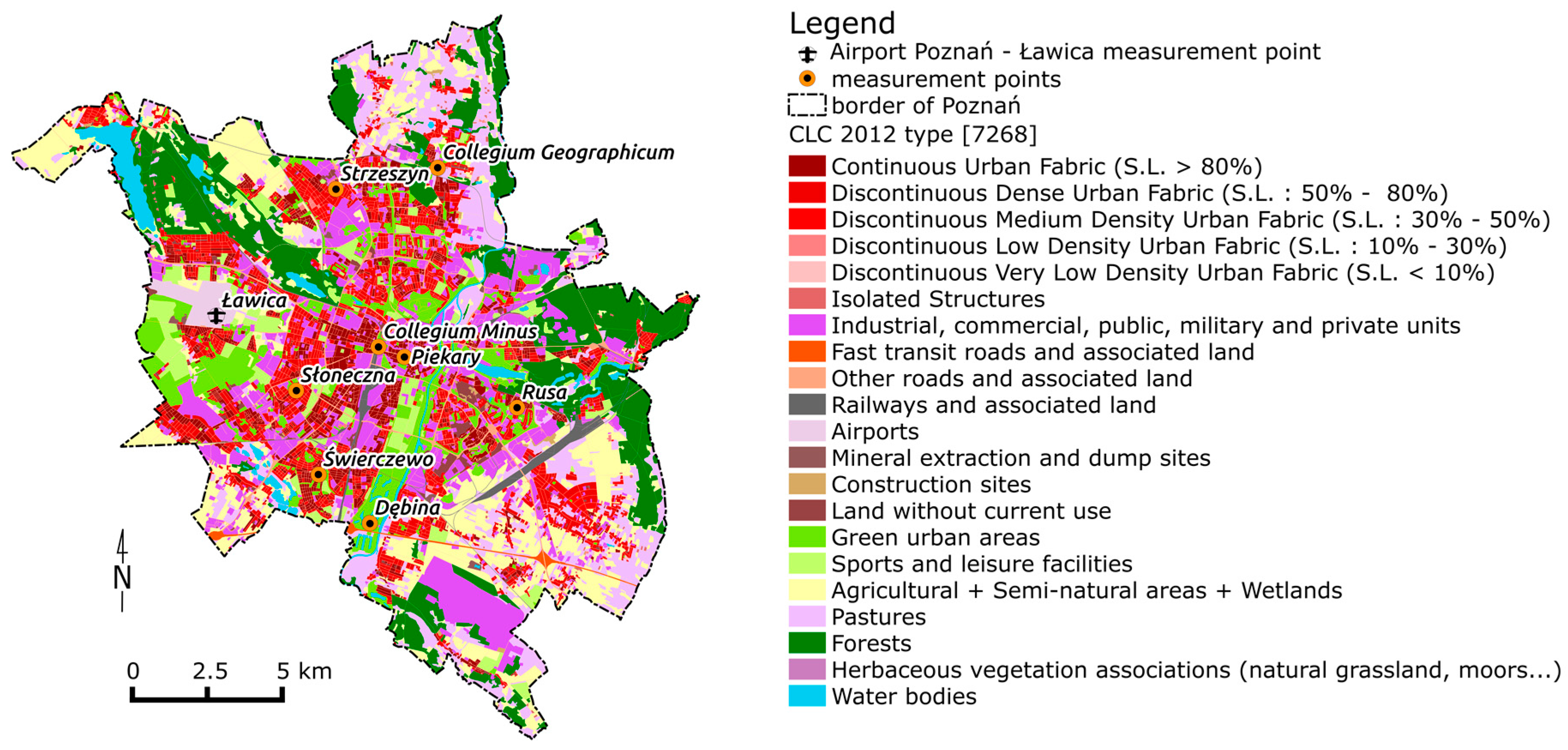
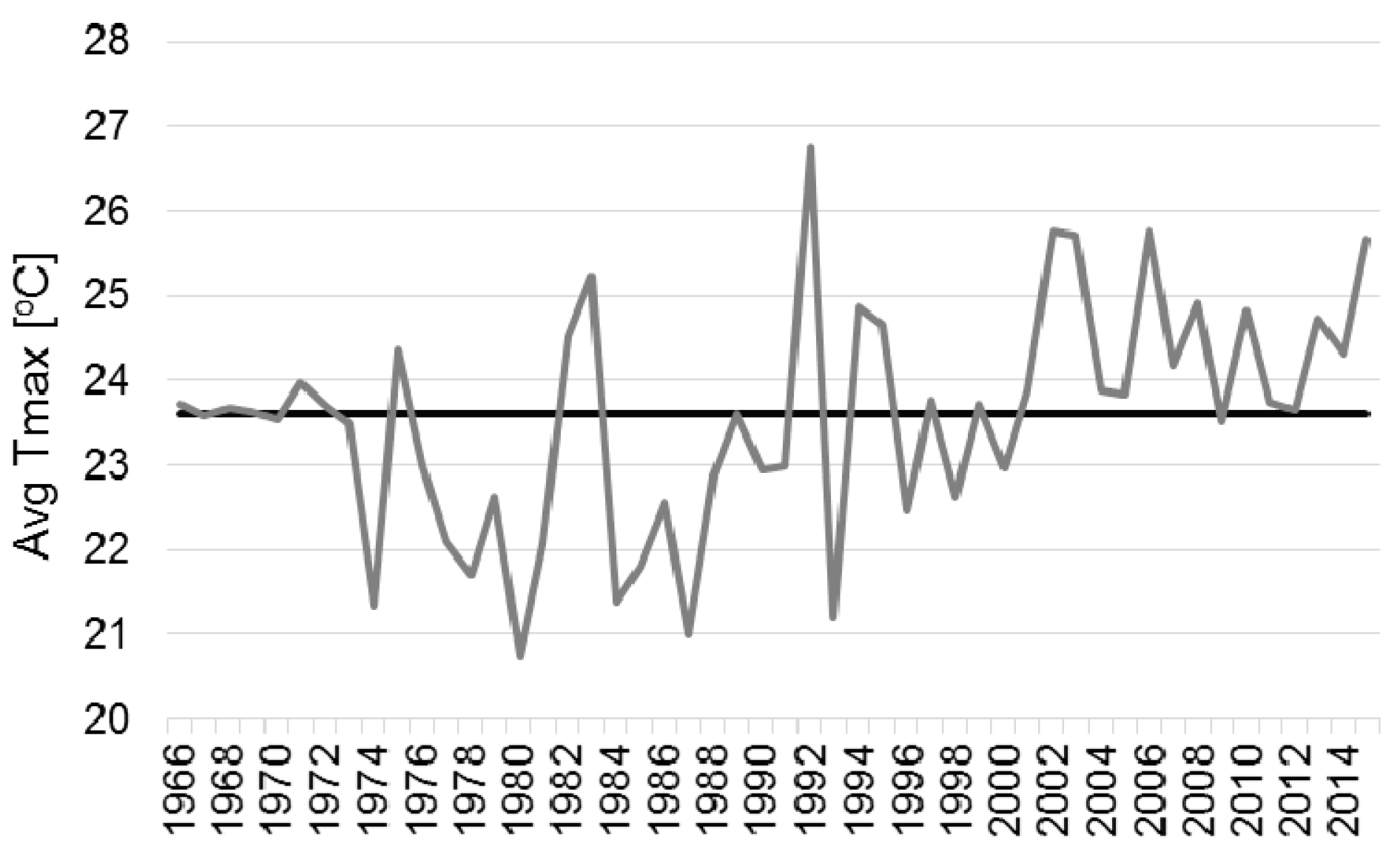

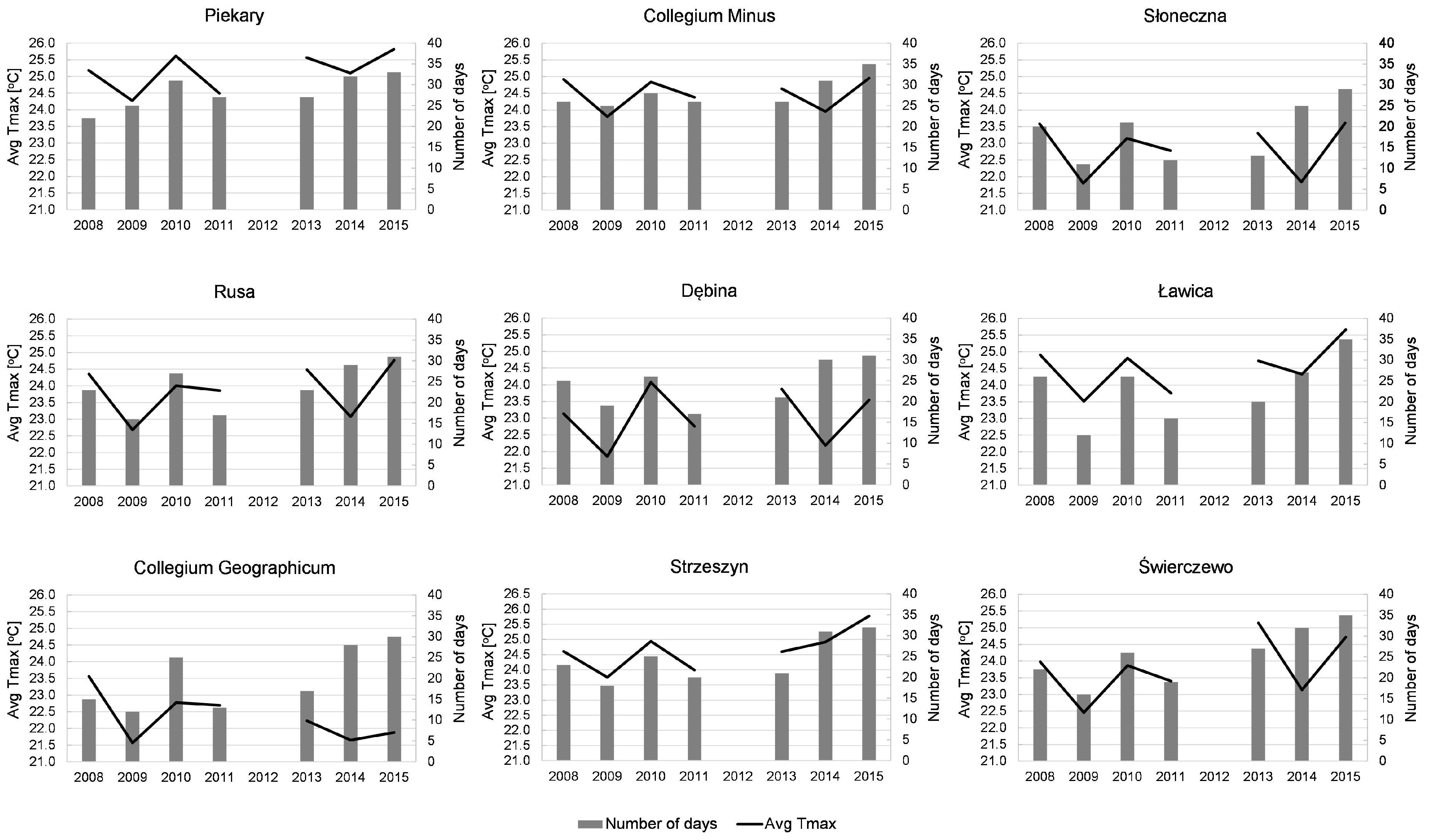
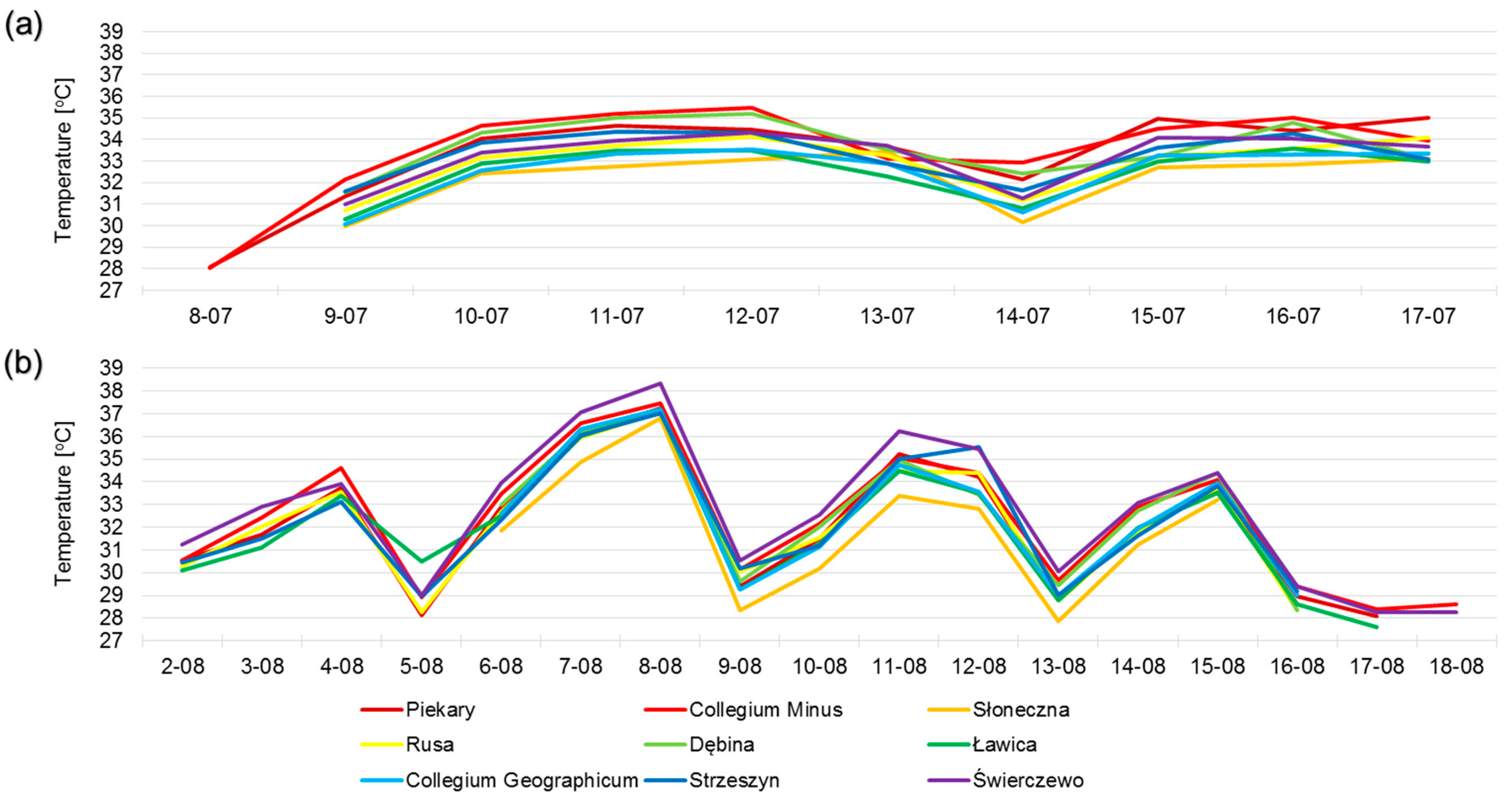
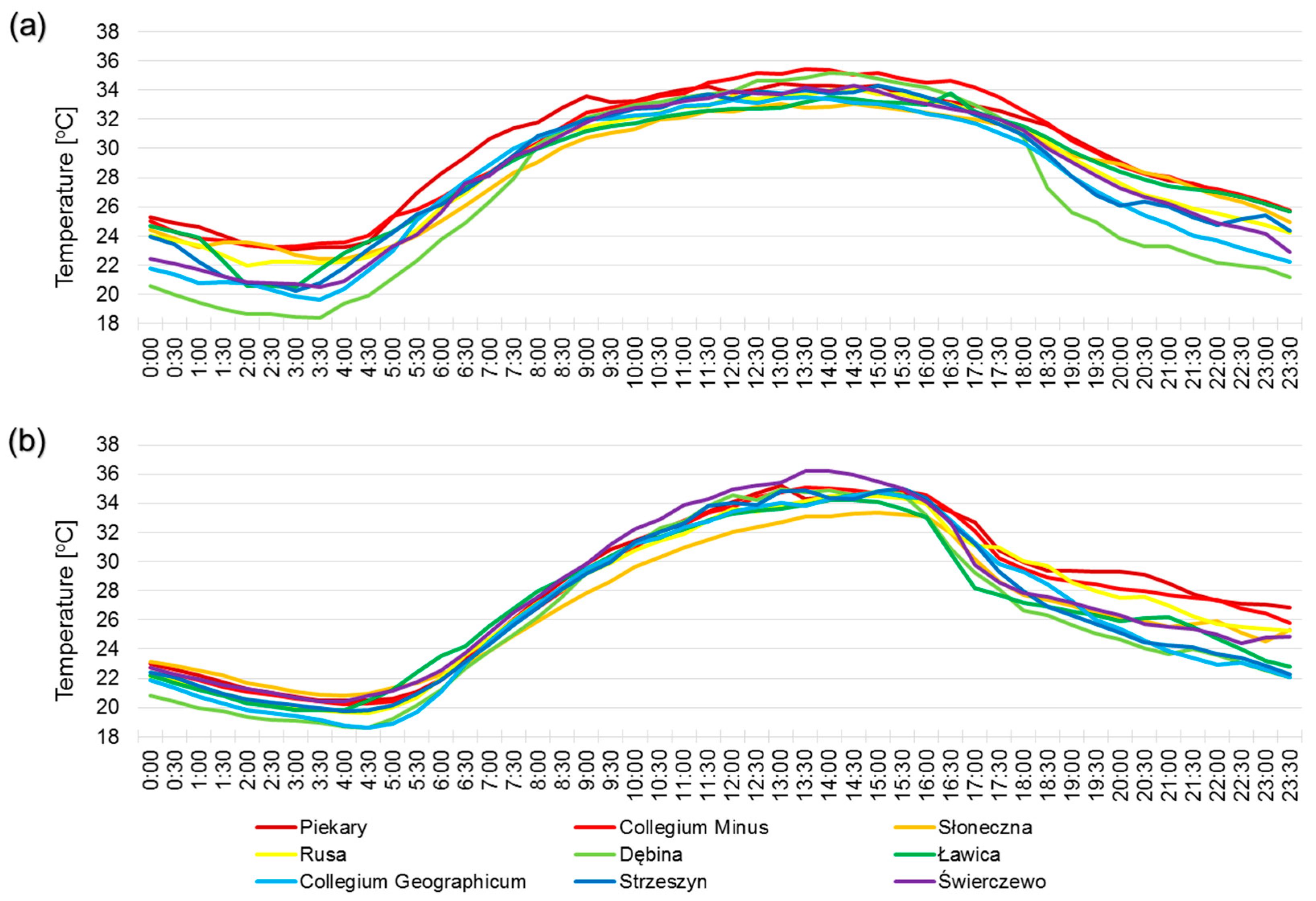

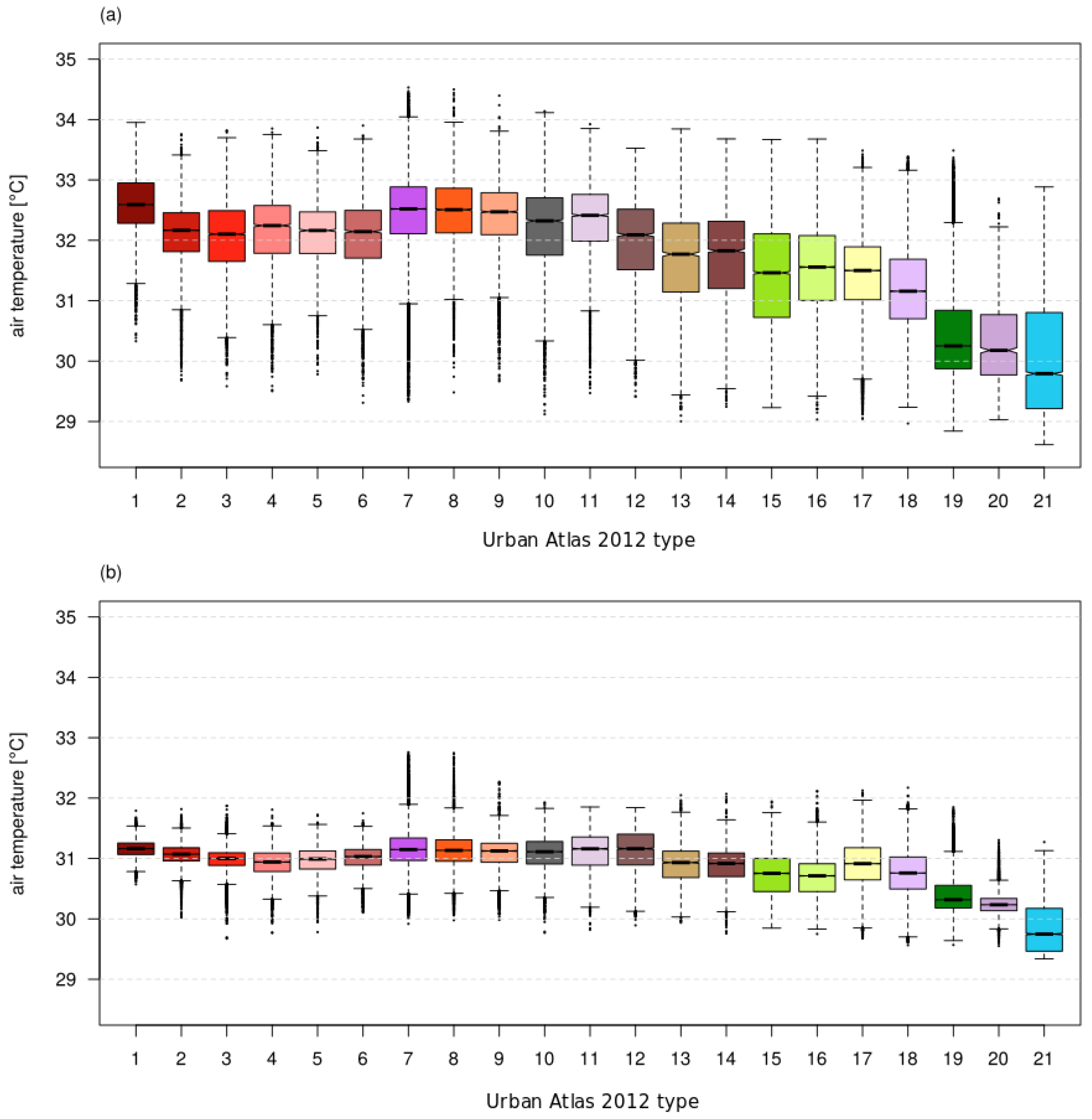
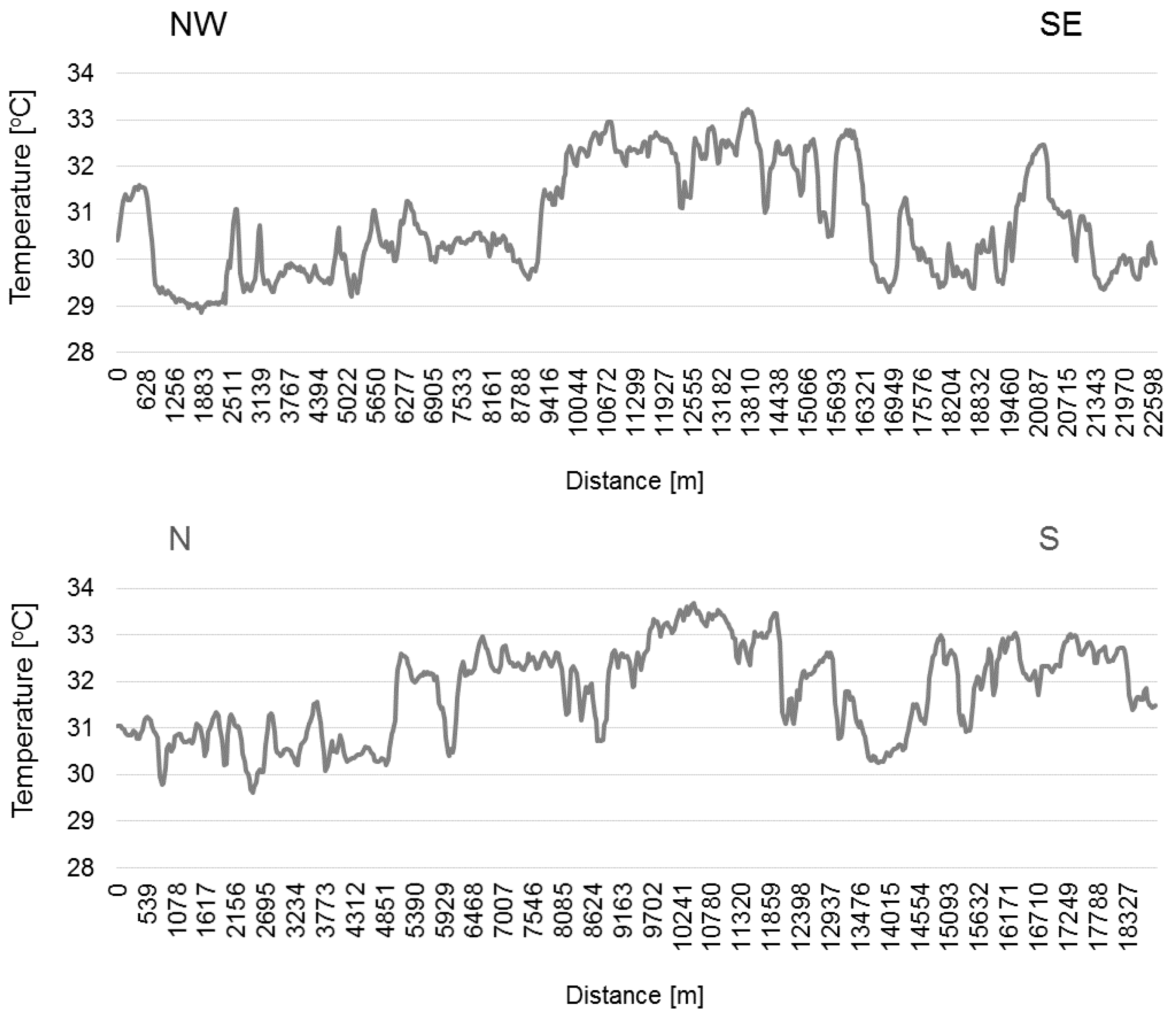
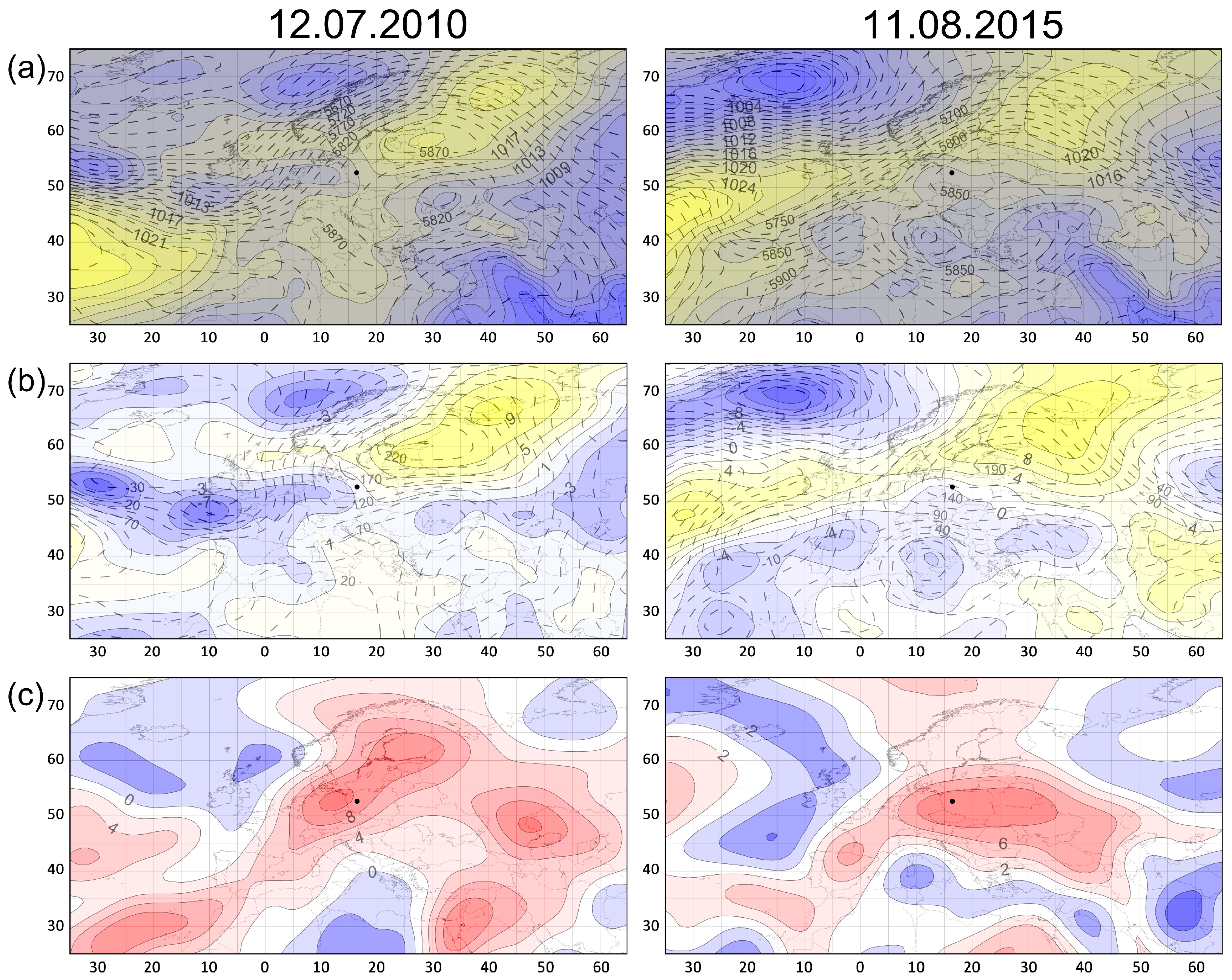

| Location | Latitude [N] | Longitude [E] | Distance from the City Center–Piekary (km)/Direction | Land Cover | |
|---|---|---|---|---|---|
| 1. | Piekary | 52°24′19.96′′ | 16°55′39.60′′ | 0.0/- | Industrial, commercial, public, military and private units |
| 2. | Collegium Minus | 52°24′31.13′′ | 16°54′53.22′′ | 0.9/W | Industrial, commercial, public, military and private units |
| 3. | Słoneczna | 52°23′40.27′′ | 16°52′29.69′′ | 3.9/W | Green urban areas |
| 4. | Rusa | 52°23′29.65′′ | 16°59′0.75′′ | 4.0/SE | Discontinuous Dense Urban Fabric |
| 5. | Dębina | 52°21′19.88′′ | 16°54′46.14′′ | 5.7/S | Green urban areas |
| 6. | Ławica | 52°24′59.46′′ | 16°50′4.71′′ | 6.9/W | Airports |
| 7. | Collegium Geographicum | 52°27′46.80′′ | 16°56′28.92′′ | 6.7/N | Industrial, commercial, public, military and private units |
| 8. | Strzeszyn | 52°27′15.14′′ | 16°50′50.79′′ | 7.7/NW | Discontinuous Dense Urban Fabric |
| 9. | Świerczewo | 52°22′11.90′′ | 16°53′56.11′′ | 4.5/S | Continuous urban fabric |
| Years | Number of Heat Waves | Total Duration of Heat Waves (Days) | Average Length (Days) | Average Tmax (°C) | Average Tmin (°C) |
|---|---|---|---|---|---|
| 1966–1975 | 6 | 51 | 8.5 | 30.7 | 16.8 |
| 1976–1985 | 9 | 57 | 6.3 | 30.1 | 16.2 |
| 1986–1995 | 9 | 63 | 7.0 | 30.6 | 15.0 |
| 1996–2005 | 7 | 42 | 6.0 | 29.9 | 14.5 |
| 2006–2015 | 11 | 97 | 8.8 | 31.2 | 17.7 |
| 1966–2015 | 42 | 310 | 7.4 | 30.5 | 16.2 |
© 2018 by the authors. Licensee MDPI, Basel, Switzerland. This article is an open access article distributed under the terms and conditions of the Creative Commons Attribution (CC BY) license (http://creativecommons.org/licenses/by/4.0/).
Share and Cite
Półrolniczak, M.; Tomczyk, A.M.; Kolendowicz, L. Thermal Conditions in the City of Poznań (Poland) during Selected Heat Waves. Atmosphere 2018, 9, 11. https://doi.org/10.3390/atmos9010011
Półrolniczak M, Tomczyk AM, Kolendowicz L. Thermal Conditions in the City of Poznań (Poland) during Selected Heat Waves. Atmosphere. 2018; 9(1):11. https://doi.org/10.3390/atmos9010011
Chicago/Turabian StylePółrolniczak, Marek, Arkadiusz M. Tomczyk, and Leszek Kolendowicz. 2018. "Thermal Conditions in the City of Poznań (Poland) during Selected Heat Waves" Atmosphere 9, no. 1: 11. https://doi.org/10.3390/atmos9010011





